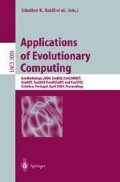Abstract
In this paper we present a new technique for automatically approximating the aesthetic fitness of evolutionary art. Instead of assigning fitness values to images interactively, we use the Universal Similarity Metric to predict how interesting new images are to the observer based on a library of aesthetic images. In order to approximate the Information Distance, and find the images most similar to the training set, we use a combination of zip-compression, for genomes, and jpeg-compression of the final images. We evaluated the prediction accuracy of our system by letting the user label a new set of images and then compare that to what our system classifies as the most aesthetically pleasing images. Our experiments indicate that the Universal Similarity Metric can successfully be used to classify what images and genomes are aesthetically pleasing, and that it can clearly distinguish between “ugly” and “pretty” images with an accuracy better than the random baseline.
Access this chapter
Tax calculation will be finalised at checkout
Purchases are for personal use only
Preview
Unable to display preview. Download preview PDF.
References
Dawkins, R.: The Blind Watchmaker, Harlow Logman (1986)
Sims, K.: Artificial Evolution for Computer Graphics. In: 1991 ACM SIGGRAPH Proceedings, Computer Graphics, vol. 25(4) (1991)
Rooke, S.: Eons of Genetically Evolved Algorithmic Images, Creative Evolutionary Systems, pp. 339–365. Morgan Kaufmann Publishers, San Francisco (2002)
Baluja, S., Pomerlau, D., Todd, J.: Towards Automated Artificial Evolution for Computer- Generated Images. Connection Science 6, 325–354 (1994)
Saunders, R., Gero, J.S.: Artificial Creativity: A Synthetic Approach to the Study of Creative Behaviour. In: Gero, J.S. (ed.) Proceedings of the Fifth Conference on Computational and Cognitive Models of Creative Design, Key Centre of Design Com-putting and Cognition (2001)
Machado, P., Cardoso, A.: NEvAr − The Assessment of an Evolutionary Art Tool. In: Wiggins, G (Ed.). Proceedings of the AISB00 Symposium on Creative & Cultural Aspects and Applications of AI & Cognitive Science, Birmingham, UK (2000)
Machado, P., Cardoso, A.: Computing Aesthetics. In: de Oliveira, F.M. (ed.) SBIA 1998. LNCS (LNAI), vol. 1515, pp. 219–228. Springer, Heidelberg (1998) ISBN 3-540-65190-X
Machado, P., Romero, J.,, Manaris, B.,, Santos, A., Cardoso, A.: Power to the Critics − A Framework for the Development of Artificial Critics. In: Proceedings of 3rd Workshop on Creative Systems, 18th International Joint Conference on Artificial Intelligence (IJCAI 2003), Acapulco, Mexico, pp. 55–64 (2003)
Li, M., Badger, J.H., Chen, X., Kwong, S., Kearney, P., Zhang, H.: An information-based sequence distance and its application to whole mitochondrial genome phylogeny. Bioinformatics 17(2), 149–154 (2001)
Li, M., Vitányi, P.: Algorithmic Complexity, International Encyclopedia of the Social & Behavioral Sciences. In: Smelser, N., Baltes, P. (eds.), Pergamon, Oxford, pp. 376–382 ((2001/2002)
Li., M., Chen, X., Li, X., Ma, B., Vitányi, P.: The Similarity Metric. In: Proceedings at the 14th ACM-SIAM Symposium on Discrete Algorithms (2003)
Li, M., Vitányi, P.: An Introduction To Kolmogorov Complexity and its Applications, 2nd edn. Springer, New York (1997)
Bennet, C., Gács, P., Li, M., Vitányi, P., Zurek, W.: Information Distance. IEEE Transactions on Information Theory 44(4), 1407–1423 (1998)
Riccardo, P., Langdon, W.B.: Submachine-code Genetic Programming, Technical Report CSRP-98-18, University of Birmingham, School of Computer Science (1998)
Svangård, N., Nordin, P., Lloyd, S.: Parallel Evolution of Trading Strategies Based on Binary Classification using Sub-Machine-Code Genetic Programming. In: proceedings at the 4th Asia-Pacific Conference on Simulated Evolution and Learning (SEAL 2002)
Author information
Authors and Affiliations
Editor information
Editors and Affiliations
Rights and permissions
Copyright information
© 2004 Springer-Verlag Berlin Heidelberg
About this paper
Cite this paper
Svangård, N., Nordin, P. (2004). Automated Aesthetic Selection of Evolutionary Art by Distance Based Classification of Genomes and Phenomes Using the Universal Similarity Metric. In: Raidl, G.R., et al. Applications of Evolutionary Computing. EvoWorkshops 2004. Lecture Notes in Computer Science, vol 3005. Springer, Berlin, Heidelberg. https://doi.org/10.1007/978-3-540-24653-4_46
Download citation
DOI: https://doi.org/10.1007/978-3-540-24653-4_46
Publisher Name: Springer, Berlin, Heidelberg
Print ISBN: 978-3-540-21378-9
Online ISBN: 978-3-540-24653-4
eBook Packages: Springer Book Archive

